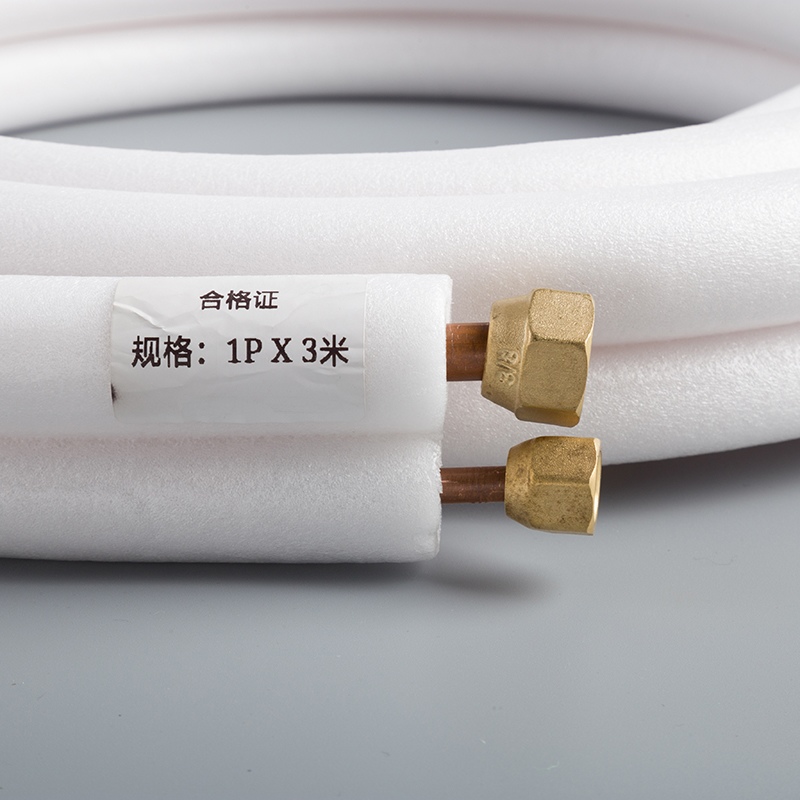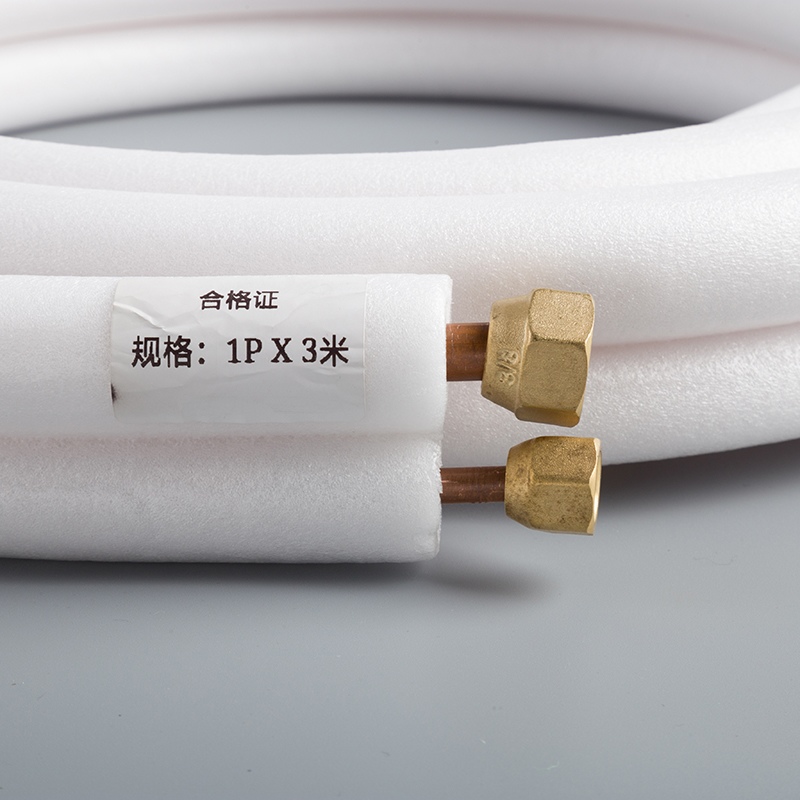How to Resolve Cooling Issues in Mitsubishi Air Conditioner Copper Pipes

Cooling issues in your mitsubishi air conditioner copper pipe can disrupt the comfort of your home. These problems often result from refrigerant leaks, blockages, or improper installation. Ignoring them can lead to reduced efficiency and costly repairs. You should act quickly to identify and resolve these issues. Regular maintenance of your HVAC system can help prevent such problems. By addressing these concerns early, you ensure your air conditioner operates efficiently and lasts longer.
Key Takeaways
Look for refrigerant leaks by feeling warm air from vents or hearing hissing sounds near pipes. Use soapy water to spot leaks fast.
Clean air filters and coils often to avoid clogs. This easy job helps airflow and keeps your air conditioner working well.
Check copper pipes for damage or rust. Finding problems early saves money and keeps cooling strong.
Get professional maintenance to find problems early. Regular check-ups make your air conditioner last longer and use less energy.
Make sure copper pipes are installed right and tightly connected. Bad alignment can cause leaks and weaker cooling.
Common Reasons Why Mitsubishi Air Conditioner Copper Pipes Are Not Cooling

Refrigerant Leaks and Their Impact
A refrigerant leak is one of the most common reasons your Mitsubishi air conditioner copper pipe may stop cooling effectively. Refrigerant is essential for absorbing heat and cooling your home. When a leak occurs, the system loses refrigerant, reducing its ability to cool.
Several factors can cause refrigerant leaks:
Low refrigerant levels may result from undercharging during installation.
A leak in the system can also lead to insufficient refrigerant levels.
You might notice warm air blowing from the vents or hear a hissing sound near the copper pipes. Ignoring a refrigerant leak can damage the compressor and increase energy bills. Addressing this issue promptly ensures your HVAC system operates efficiently.
Blockages in the Copper Pipes
Blockages in the copper pipes can also disrupt cooling. Dirt, debris, or oil buildup inside the pipes restricts refrigerant flow. This restriction prevents the system from cooling your home effectively. You may observe uneven cooling or hear unusual noises from the air conditioner.
To resolve this, you need to clear the blockage. Regular maintenance, such as cleaning the system and inspecting the pipes, can help prevent this issue. Keeping the copper pipes clean ensures smooth refrigerant flow and optimal cooling performance.
Frozen AC Line Due to Airflow Restrictions
A frozen AC line is another common issue that affects cooling. This problem often arises from restricted airflow caused by dirty air filters, blocked vents, or low refrigerant levels. Signs of a frozen line include:
The AC unit running continuously without cooling your home.
Hissing or buzzing sounds from the outdoor condenser.
Higher energy bills during peak cooling seasons.
To fix this, you should turn off the air conditioner and allow the lines to thaw. Cleaning or replacing air filters and ensuring proper airflow can prevent this issue from recurring. Regular inspections help identify and address airflow problems early.
Damaged or Corroded Copper Pipes
Damaged or corroded copper pipes can significantly impact your air conditioner's cooling performance. Over time, exposure to moisture, chemicals, or physical wear can weaken the pipe's structure. This damage may lead to refrigerant leaks or restricted flow, reducing the system's efficiency.
You can identify corroded pipes by looking for greenish or bluish discoloration on the surface. Physical damage, such as dents or cracks, is also a clear sign of trouble. If you notice these issues, you should act quickly to prevent further complications.
Tip: Regularly inspect the copper pipes for signs of wear and tear. Early detection can save you from costly repairs.
To address this problem, you may need to replace the damaged section of the pipe. In some cases, professional repair services are necessary to ensure proper sealing and functionality. Protecting the pipes from external elements, such as moisture or physical impact, can help prevent future damage.
Insufficient Refrigerant Levels or Improper Charging
Low refrigerant levels can cause your Mitsubishi air conditioner copper pipe to stop cooling effectively. This issue often arises from leaks or improper refrigerant charging during installation. Without enough refrigerant, the system cannot absorb and release heat efficiently.
Signs of low refrigerant include:
Warm air blowing from the vents.
Ice buildup on the evaporator coil.
Increased energy consumption.
If you suspect low refrigerant levels, you should contact a professional technician. They can locate and fix leaks, then recharge the system to the correct level. Attempting to handle refrigerant yourself can be dangerous and may void your warranty.
Note: Always ensure a certified technician handles refrigerant-related issues. Proper charging is crucial for optimal cooling performance.
Preventing this problem involves regular maintenance and professional inspections. These steps ensure the refrigerant system remains sealed and operates efficiently.
How to Diagnose Cooling Issues in Mitsubishi Air Conditioner Copper Pipes
Identifying Refrigerant Leaks
Refrigerant leaks are a common cause of cooling issues in your Mitsubishi air conditioner copper pipe. To identify a leak, you can look for specific signs. Warm air from the vents, hissing sounds near the pipes, or ice buildup on the evaporator coil often indicate a problem.
A simple method to confirm a leak involves using soapy water. Spray the solution along the copper pipes and watch for bubbles forming. These bubbles reveal the exact location of the leak. Addressing leaks promptly prevents further damage to your HVAC system and ensures efficient cooling.
Tip: Regularly inspect the pipes for any unusual sounds or visible damage. Early detection can save you from costly repairs.
Checking for Blockages in the Pipes
Blockages in the copper pipes can restrict refrigerant flow, reducing your air conditioner's cooling performance. To check for blockages, touch along the length of the pipe. Cool spots often indicate a blockage.
You should also clean the compressor and coils to ensure proper airflow. Debris around the compressor can contribute to blockages and strain the system. Keeping these components clean helps maintain smooth refrigerant flow and prevents cooling disruptions.
Note: Regular maintenance, including cleaning and inspections, minimizes the risk of blockages and extends the life of your HVAC system.
Inspecting for Frozen AC Lines
A frozen HVAC unit often results from restricted airflow or low refrigerant levels. To inspect for frozen lines, look for visible ice on the copper pipes or evaporator coil. You may also notice the air conditioner running continuously without cooling your home.
If you find frozen lines, turn off the system immediately and allow it to thaw. Check the air filters and vents for dirt or obstructions. Cleaning or replacing dirty filters restores proper airflow and prevents the issue from recurring.
Reminder: Never ignore frozen lines, as they can lead to more severe problems like compressor damage.
Examining the Condition of the Copper Pipes
You should regularly inspect the copper pipes in your Mitsubishi air conditioner to ensure they remain in good condition. Damaged or worn pipes can lead to refrigerant leaks, reduced cooling efficiency, and higher energy bills. Start by visually examining the pipes for any signs of corrosion, discoloration, or physical damage like cracks or dents. Corrosion often appears as green or bluish spots on the pipe's surface, indicating exposure to moisture or chemicals.
Run your hand along the length of the pipe to feel for irregularities. Cool spots or uneven temperatures may signal blockages or leaks. If you notice any unusual sounds, such as hissing or bubbling, these could also point to a refrigerant leak. In such cases, you should act quickly to prevent further damage to the system.
Tip: Use a flashlight to inspect hard-to-reach areas of the pipes. This helps you spot hidden damage that might otherwise go unnoticed.
If you find significant damage, replacing the affected section of the pipe may be necessary. For minor issues, sealing the pipe with a professional-grade sealant can temporarily resolve the problem. However, you should always consult a certified technician for a permanent fix.
Verifying Proper Installation and Connections
Improper installation or loose connections can cause your Mitsubishi air conditioner copper pipe to malfunction. Poorly connected pipes may lead to refrigerant leaks or restricted flow, reducing the system's cooling performance. To verify the installation, check that all connections are secure and properly sealed. Loose fittings can often be tightened with a wrench, but avoid overtightening, as this can damage the pipe.
Inspect the alignment of the pipes. Misaligned pipes can strain the system and increase the risk of leaks. Ensure the pipes are not bent or kinked, as this can restrict refrigerant flow. If you suspect improper installation, it’s best to consult a professional technician. They can assess the setup and make necessary adjustments to optimize performance.
Reminder: Always follow the manufacturer’s guidelines for installation and maintenance. This ensures your system operates efficiently and avoids voiding the warranty.
Regularly checking the connections and alignment helps maintain the efficiency of your air conditioner. It also prevents long-term issues that could lead to costly repairs.
Step-by-Step Guide to Fix Cooling Issues in Mitsubishi Air Conditioner Copper Pipes

Repairing or Replacing Damaged Copper Pipes
Damaged copper pipes can disrupt your air conditioner's cooling efficiency. To repair or replace them, follow these steps:
Cut and replace the damaged section: Use a pipe cutter to remove the faulty part. Replace it with a new section using slip couplings.
Use compression couplings: Cut out the damaged area and secure the new pipe with compression fittings. This method is user-friendly and effective.
Apply a Sharkbite slip coupling: Push this fitting over the damaged pipe to seal a single hole quickly.
Install a repair clamp: For a temporary fix, secure a clamp over the hole in the pipe.
Solder small holes shut: Clean the area, apply flux, and use solder to seal minor holes.
Tip: Always inspect the repaired section for leaks before reconnecting the system.
If the damage is extensive, consider replacing the entire pipe. This ensures the system operates efficiently and prevents future issues.
Fixing Refrigerant Leaks and Refilling Refrigerant
Refrigerant leaks can severely impact your air conditioner's performance. To fix them safely, take these precautions:
Wear protective gear like gloves, safety glasses, and a respirator.
Work in a well-ventilated area to avoid inhaling refrigerant fumes.
Depressurize the system before starting repairs.
Once safe, locate the leak using soapy water. Apply the solution to the pipes and watch for bubbles. After identifying the leak, seal it with a professional-grade sealant or replace the damaged section. Use a recovery machine to capture any escaping refrigerant.
After repairing the leak, refill the refrigerant to the correct level. This step requires specialized equipment and should be handled by a certified HVAC technician. Proper refrigerant levels ensure your system cools efficiently and avoids further damage.
Reminder: Mishandling refrigerants can be dangerous. Always follow safety guidelines and consult a professional when needed.
Clearing Blockages in the Copper Pipes
Blockages in the copper pipes can restrict refrigerant flow, reducing cooling performance. To clear them, disconnect air conditioner lines and inspect for dirt or debris. Use a pipe cleaner or compressed air to remove obstructions.
If the blockage persists, check the compressor and coils for buildup. Clean these components to restore proper airflow. Regular maintenance, such as cleaning and inspecting the pipes, prevents blockages and extends the life of your HVAC system.
Note: After clearing the blockage, reconnect pipes securely to avoid leaks or misalignment.
By addressing blockages promptly, you ensure smooth refrigerant flow and optimal cooling performance.
Thawing Frozen AC Lines Safely
Frozen AC lines can disrupt your air conditioner's cooling performance. This issue often occurs when airflow is restricted or refrigerant levels drop. To thaw the lines safely, follow these steps:
Turn off the air conditioner: Shut down the system immediately to prevent further damage. Allow the frozen hvac unit to defrost naturally.
Inspect the air filters and vents: Dirty filters or blocked vents often cause restricted airflow. Clean or replace the filters and remove any obstructions from the vents.
Check refrigerant levels: Low refrigerant levels can lead to freezing. Contact a professional technician to inspect and refill the refrigerant if necessary.
Use a fan to speed up thawing: Place a fan near the frozen lines to circulate air and accelerate the thawing process. Avoid using heat sources, as they can damage the pipes.
Tip: Never attempt to scrape off the ice manually. This can damage the copper pipes and lead to costly repairs.
Once the lines are thawed, restart the air conditioner and monitor its performance. If the issue persists, consult a certified technician to identify and address the root cause. Regular maintenance, such as cleaning filters and checking refrigerant levels, can help prevent freezing in the future.
Addressing Installation or Connection Problems
Improper installation or loose connections can reduce your air conditioner's efficiency. To address these problems, start by inspecting the copper pipes and connections. Look for signs of misalignment, loose fittings, or bent pipes. Tighten any loose connections using a wrench, but avoid overtightening to prevent damage.
If you suspect improper installation, review the manufacturer's guidelines. Ensure the pipes are correctly aligned and securely fastened. Misaligned pipes can restrict refrigerant flow and strain the system. For complex issues, seek professional repair services to ensure proper installation.
Reminder: Always use certified technicians for installation and repairs. This ensures your system operates efficiently and avoids voiding the warranty.
Regularly checking the connections and alignment helps maintain your air conditioner's performance. It also prevents long-term issues that could lead to expensive repairs.
Preventive Measures to Avoid Cooling Issues in Mitsubishi Air Conditioner Copper Pipes
Regular Maintenance and Professional Inspections
Regular maintenance plays a vital role in keeping your Mitsubishi air conditioner running efficiently. Scheduling professional maintenance ensures your system operates at peak performance. It also helps you avoid unexpected breakdowns.
Here are some benefits of regular maintenance:
Improved air quality through clean filters.
Increased efficiency, which lowers energy bills.
Preventative care to avoid costly repairs.
Professional inspections provide additional advantages. HVAC technicians can identify hidden issues before they escalate. They also extend the lifespan of your air conditioner by addressing problems early.
Regular inspections allow HVAC professionals to clean and tune-up your system, ensuring it operates at its peak efficiency. Preventive maintenance helps identify potential issues before they escalate into costly repairs.
By committing to regular maintenance, you save money and ensure your air conditioner performs optimally during peak usage times.
Cleaning Air Filters and Coils
Dirty air filters and coils can restrict airflow, reducing your air conditioner's cooling efficiency. Cleaning these components regularly prevents such issues. For optimal performance, clean Mitsubishi heat pump filters every three months. If you live in a dusty area or one with high pollen levels, increase the cleaning frequency.
Neglecting this task can lead to higher energy bills and strain on your HVAC system. Clean filters improve airflow, ensuring your air conditioner cools your home effectively. Regularly cleaning the coils also prevents dirt buildup, which can hinder heat exchange.
Tip: Set a reminder to clean your air filters and coils at the start of each season. This simple habit can significantly improve your system's efficiency.
Protecting Copper Pipes from External Damage
Protecting the copper pipes in your air conditioner prevents corrosion and physical damage. Corrosion risks increase when pipes are exposed to moisture or contaminants. To minimize these risks, follow these best practices:
Assess the water supply for corrosion risks and implement mitigation strategies.
Design the plumbing system to prevent stagnation and ensure proper water flow.
Use monitoring equipment to detect conditions that may lead to corrosion.
Flush the system regularly to remove contaminants and maintain water quality.
By taking these steps, you safeguard your copper pipes from damage. This ensures your air conditioner operates efficiently and lasts longer.
Ensuring Proper Usage and Ventilation
Proper usage and ventilation play a crucial role in maintaining your Mitsubishi air conditioner's efficiency. Misusing the system or neglecting ventilation can lead to cooling issues and unnecessary wear on the unit. By following a few simple practices, you can ensure your air conditioner operates at its best.
Tips for Proper Usage
Set the thermostat wisely: Keep the temperature at a comfortable level, typically between 72°F and 78°F. Avoid extreme settings, as they can overwork the system.
Avoid frequent on-off cycles: Turning the air conditioner on and off repeatedly can strain the compressor. Let the system run for longer periods to maintain consistent cooling.
Use energy-saving modes: Many Mitsubishi air conditioners come with eco-friendly settings. These modes optimize performance while reducing energy consumption.
Close windows and doors: Prevent warm air from entering the room by keeping windows and doors shut while the air conditioner is running.
Tip: Use ceiling fans alongside your air conditioner to circulate cool air more effectively. This reduces the load on your HVAC system.
Ensuring Adequate Ventilation
Ventilation is essential for proper airflow and cooling efficiency. Blocked vents or poor air circulation can cause uneven cooling and strain the system. Here’s how you can improve ventilation:
Keep vents clear: Ensure that furniture, curtains, or other objects do not block air vents. This allows air to flow freely throughout the room.
Inspect outdoor units: Check the outdoor condenser for debris, leaves, or dirt. Clean the area around it to maintain unrestricted airflow.
Use exhaust fans: In areas like kitchens or bathrooms, exhaust fans help remove heat and humidity, reducing the load on your air conditioner.
Reminder: Regularly check your air conditioner's user manual for specific guidelines on usage and ventilation. Following these recommendations ensures optimal performance and extends the unit's lifespan.
By using your air conditioner correctly and maintaining proper ventilation, you can enjoy consistent cooling while minimizing energy costs.
When to Seek Professional Air Conditioner Repair Services
Persistent Cooling Issues Despite Troubleshooting
Sometimes, even after following all troubleshooting steps, your air conditioner may still fail to cool effectively. Persistent issues like warm air blowing from the vents or little airflow indicate deeper problems. You might also notice strange odors when the system runs or hear loud noises from the indoor or outdoor unit. These signs suggest that the problem goes beyond basic maintenance.
If your air conditioner repair attempts do not resolve the issue, it’s time to call a professional. A certified technician can diagnose the root cause and provide a long-term solution. Ignoring these signs could lead to more severe damage and higher repair costs.
Extensive Damage to Copper Pipes or Refrigerant System
Extensive damage to the copper pipes or refrigerant system often requires professional intervention. Corroded or cracked pipes can cause refrigerant leaks, reducing the system's efficiency. You may also notice water pooling around the outdoor unit or ice forming on the lines. These issues can strain the compressor and lead to costly repairs if left unaddressed.
A professional technician has the tools and expertise to repair or replace damaged components safely. They can also refill refrigerant to the correct levels, ensuring your air conditioner operates efficiently. Attempting to fix these problems yourself may worsen the damage or void your warranty.
Choosing a Certified Mitsubishi Air Conditioner Specialist
When selecting a technician, always choose a certified Mitsubishi air conditioner specialist. These professionals have the training and experience to handle your system’s specific requirements. They can identify issues quickly and ensure repairs meet the manufacturer’s standards.
Look for technicians with positive reviews and proper licensing. A reliable specialist will also provide a detailed estimate before starting any work. This transparency helps you understand the scope of the repair and avoid unexpected costs.
Tip: Regular maintenance by a certified specialist can prevent many common issues and extend your air conditioner’s lifespan.
By seeking professional air conditioner repair services when needed, you protect your investment and ensure consistent cooling performance.
Cooling issues in Mitsubishi air conditioner copper pipes often result from common causes like low refrigerant levels, blockages, or a malfunctioning compressor. Regular maintenance increases performance and extends the lifespan of your unit, saving you money on repairs and replacements. While basic troubleshooting can resolve minor problems, professional assistance ensures reliable results. Experts possess the knowledge to handle complex tasks safely and efficiently, preventing unnecessary energy costs. By prioritizing timely repairs and professional care, you can maintain optimal cooling performance and avoid long-term damage to your system.
FAQ
What are the signs of a refrigerant leak in copper pipes?
You may notice warm air blowing from the vents, hissing sounds near the pipes, or ice forming on the evaporator coil. These signs indicate a refrigerant leak that needs immediate attention.
Tip: Use soapy water to detect leaks. Bubbles will form at the leak site.
How often should you clean air filters and coils?
Clean air filters every three months for optimal performance. If you live in a dusty area or have pets, clean them more frequently. Coils should be inspected and cleaned annually to prevent dirt buildup and ensure efficient cooling.
Reminder: Set a seasonal reminder to clean filters and coils.
Can you fix copper pipe damage yourself?
Minor damage, like small holes, can be temporarily sealed with repair clamps or soldering. However, extensive damage requires professional repair or replacement to ensure proper sealing and functionality.
Note: Attempting complex repairs yourself may void your warranty. Always consult a certified technician for major issues.
Why do AC lines freeze, and how can you prevent it?
Frozen lines occur due to restricted airflow or low refrigerant levels. Prevent this by cleaning air filters regularly, ensuring vents remain unblocked, and scheduling professional maintenance.
Tip: Turn off the AC immediately if you notice frozen lines to avoid further damage.
When should you call a professional for cooling issues?
Call a professional if cooling issues persist after troubleshooting, or if you notice extensive pipe damage or refrigerant leaks. Certified technicians can diagnose and fix complex problems safely and efficiently.
Reminder: Regular professional inspections help prevent major issues and extend your system’s lifespan.
See Also
The Cooling Power of Pure Copper Pipes in AC Units
How Pure Copper Pipes Enhance Air Conditioning Performance
Transforming Air Conditioning Efficiency with Copper Pipe Technology
Maximize Your AC Efficiency Using Copper Pipe Insulation Tips


